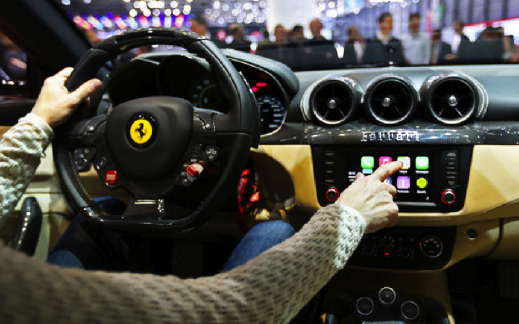Apple’s Real Car Play
It’s been fascinating to read all the recent discussion and speculation over Apple’s supposed car project—and to wonder if a company that already dominates several huge product categories thanks to innovative design and engineering might pull off the same trick with the automobile.

I think most of the talk misses an important point, though. Apple may well intend to reinvent driving, but it hardly needs to build its own car to do that. Its ambitions are, I think, more likely focused on the software and interfaces found in vehicles—the code that shapes the driving experience, and increasingly makes vehicles actually run—than on developing the expertise needed to manufacture hardware such as chassis and brake lights. To some degree, Apple has already begun this journey with Car Play, software preinstalled in some new cars that transfers functionality from an iPhone to the vehicle’s interior (see above).
Apple, of course, has a remarkable record of inventing or reinventing hit products and taking over industries. But as the Economist points out, there are significant differences between the consumer electronics and automotive businesses. More important, replicating all the manufacturing carmakers already do isn’t where the real opportunity lies. A smarter strategy, surely, would be to invest in developing new software, and maybe some new hardware, that transforms the driving experience, and then sell that technology to as many car manufacturers as possible.
This is one area of the auto industry that does seem ripe for the Apple touch. The interfaces in cars are inconsistent at best, and often downright infuriating. The road that began with Car Play could gradually lead Apple to control more and more of the information, entertainment, and services found in cars. This would play to its considerable strengths in design, UX, and software/hardware integration while also helping lock people into its ecosystem—something that serves its existing hardware and software products nicely.
The vehicle interface might seem like a small part of the auto picture, but appearances can be deceptive. As cars become more automated, the interface will play an important role, helping drivers manage automation and helping cars manage their drivers’ attention (see “Proceed with Caution Toward the Self-Driving Car”). Apple might eventually reach further into the vehicle, offering software that monitors engine performance, power systems, sensors, and so forth. The company’s rumored research on vehicle sensors and batteries would fit with such a plan.
All this might seem like a distinctly Microsoft approach. But then, perhaps Apple envisions a future in which information, services, and entertainment are not served from any one product or device—but from a whole host of intelligent gadgets and appliances. In such a world, rewriting the code that runs inside cars would be more transformative than building one from scratch.
Keep Reading
Most Popular
Large language models can do jaw-dropping things. But nobody knows exactly why.
And that's a problem. Figuring it out is one of the biggest scientific puzzles of our time and a crucial step towards controlling more powerful future models.
The problem with plug-in hybrids? Their drivers.
Plug-in hybrids are often sold as a transition to EVs, but new data from Europe shows we’re still underestimating the emissions they produce.
Google DeepMind’s new generative model makes Super Mario–like games from scratch
Genie learns how to control games by watching hours and hours of video. It could help train next-gen robots too.
How scientists traced a mysterious covid case back to six toilets
When wastewater surveillance turns into a hunt for a single infected individual, the ethics get tricky.
Stay connected
Get the latest updates from
MIT Technology Review
Discover special offers, top stories, upcoming events, and more.